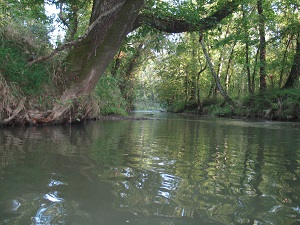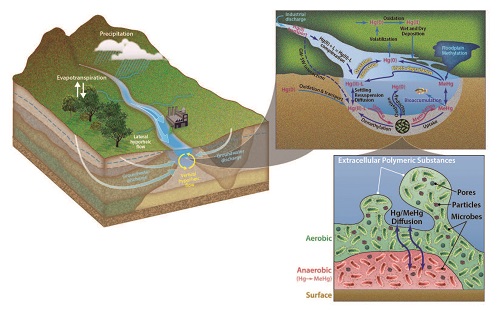
Biogeochemical Transformations at Critical Interfaces
ORNL Mercury Science Focus Area (SFA)
Research Areas
- Overview
- Ecosystem Processes
- Microbial Community Processes
- Biogeochemical Processes
- Field-scale Modeling Activity
SFA Study Area. East Fork Poplar Creek (EFPC), which is part of the 40,910 mi2 Tennessee River basin, is the representative test bed system being studied. This watershed and its associated streams represent the most intensively used freshwater Water Resource Region in the contiguous United States, with estimated withdrawals of >280,000 gallons/day/mi2.
Research Elements of the Scientific Focus Area. Transient storage zones (TSZs) depicted in the schematic are broadly defined as surface and subsurface locations (both metabolically active and inactive). TSZs significantly delay the downstream movement of water flowing through those locations (e.g., creek margins, periphyton biofilms, hyporheic zones, and bank storage), as compared to the flow pace in the stream channel. Metabolically inactive zones (e.g., surface water eddies) are not rendered or discussed here. Shown in the composite of research elements are metabolically active TSZs (MATSZs)— “hot spots” for biogeochemical transformations, such as of mercury and nutrients, that can exert a controlling influence on downstream water quality. Although MATSZs typically are associated with the interstitial spaces of a hyporheic zone streambed, the pore spaces (inset, bottom) in the microbiome of in-stream periphyton biofilms have received far less attention from researchers.

ORNL Mercury SFA sponsored by Subsurface Biogeochemical Research (SBR) program, U.S. Department of Energy's Office of Biological and Environmental Research. Paul Bayer, SBR Program Manager.
Security Notice | Contact Eric Pierce, ORNL | Website Questions | Site Map
File last modified: Tuesday, February 04, 2020
The ORNL Mercury SFA is sponsored by the Subsurface Biogeochemical Research (SBR) program within the U.S. Department of Energy's Office of Biological and Environmental Research.




